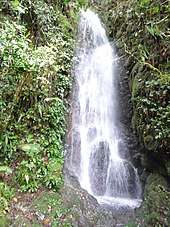Peak farmland
Peak farmland is the maximum usable amount of land needed for crop cultivation (agricultural land) for a given region (country or an entire world).[1][2] Supporters of the peak farmland theory argue that even with the growing world population, the need for more farmland is decreasing, as food production yields per acre of farmland are rising faster than the global demand for food.[3] This is supported by the fact that the area dedicated to farmland in some countries, both developed (e.g. Finland) and developing (e.g. India, China), has already begun to decline.[4][5] Globally, while the total amount of arable land is still increasing, the area of permanent pasture has been in decline since 1998, with at least 60 million hectares no longer grazed.[6] It is argued that other countries, such as the United States, are at their peak farmland now.[7]
Description
The concept is usually referenced to the work of Jesse Ausubel and Iddo Wernick.[1][8][9] They predict that over the next fifty years an area of at least 146 million hectares is going to be released from farming and will probably revert to its natural state.[9] As land conversion (from a natural state to human use) is one of the greatest threats to the natural environment in general, and biodiversity in particular, this is seen as good for the environment.[10]
Together with Iddo Wernick [...] we believe that humanity has reached Peak Farmland, and that a large net global restoration of land to Nature is ready to begin. Happily, the cause is not exhaustion of arable land, as many have feared, but rather moderation of population and tastes and ingenuity of farmers. – Jesse H. Ausubel[11]
Geisler and Currens note, however, that "Peak Farmland, though newly named, is a long-standing issue" that has been debated by scholars for decades.[2] The issue deals with two opposing views: one that predicts that more and more farmland will be needed to sustain the growing world population, and the other (the peak farmland view) that progress in agricultural techniques, measured in steadily increasing crop yields from a set amount of farmland, will result in a decrease in the amount of farmland needed to feed the world's population, eventually leading to a decrease in the world's acreage of farmland.[5][8]
References
- Sandström, Vilma; Saikku, Laura; Antikainen, Riina; Sokka, Laura; Kauppi, Pekka (15 April 2014). "Changing impact of import and export on agricultural land use: The case of Finland 1961–2007". Agriculture, Ecosystems & Environment. 188: 163–168. doi:10.1016/j.agee.2014.02.009.
- Charles Geisler; Ben Currens (20 December 2013). ""Peak Farmland": Revealed Truth or Recreancy?". William R. Freudenburg, A Life in Social Research. Research in Social Problems and Public Policy. 21. Emerald Group Publishing Limited. pp. 177–199. doi:10.1108/s0196-1152(2013)0000021012. ISBN 978-1-78190-734-4.
- "What is peak farmland?". Kate Prengaman. 8 January 2013. Archived from the original on 24 October 2016. Retrieved 24 October 2016.
- Sandström, Vilma; Saikku, Laura; Antikainen, Riina; Sokka, Laura; Kauppi, Pekka (15 April 2014). "Changing impact of import and export on agricultural land use: The case of Finland 1961–2007". Agriculture, Ecosystems & Environment. 188: 163–168. doi:10.1016/j.agee.2014.02.009.
- ""Peak farmland" is here, crop area to diminish: study". Reuters. 17 December 2016. Retrieved 18 October 2016.
- Poore, Joseph (January 2016). "Call for conservation: Abandoned pasture". Science. 351 (6269): 132. Bibcode:2016Sci...351..132P. doi:10.1126/science.351.6269.132-a. PMID 26744398.
- "The Return of Nature – How Technology Liberates the Environment". thebreakthrough.org. Retrieved 24 October 2016.
- Johan Norberg (1 September 2016). Progress: Ten Reasons to Look Forward to the Future. Oneworld Publications. p. 236. ISBN 978-1-78074-951-8.
- Robert Bryce (13 May 2014). Smaller Faster Lighter Denser Cheaper: How Innovation Keeps Proving the Catastrophists Wrong. PublicAffairs. p. 151. ISBN 978-1-61039-206-8.
- "Are We Close to Peak Farmland? | Conservancy Talk". Conservancy Talk. 22 January 2013. Retrieved 24 October 2016.
- Jesse H. Ausubel, Peak Farmland, Lecture for the 18 December 2012 Symposium in Honor of the 80th Birthday of Paul Demeny and his retirement as editor of Population and Development Review
Further reading
- Ausubel, Jesse H.; Wernick, Iddo K.; Waggoner, Paul E. (1 February 2013). "Peak Farmland and the Prospect for Land Sparing". Population and Development Review. 38: 221–242. doi:10.1111/j.1728-4457.2013.00561.x. hdl:10.1111/j.1728-4457.2013.00561.x. ISSN 1728-4457.
